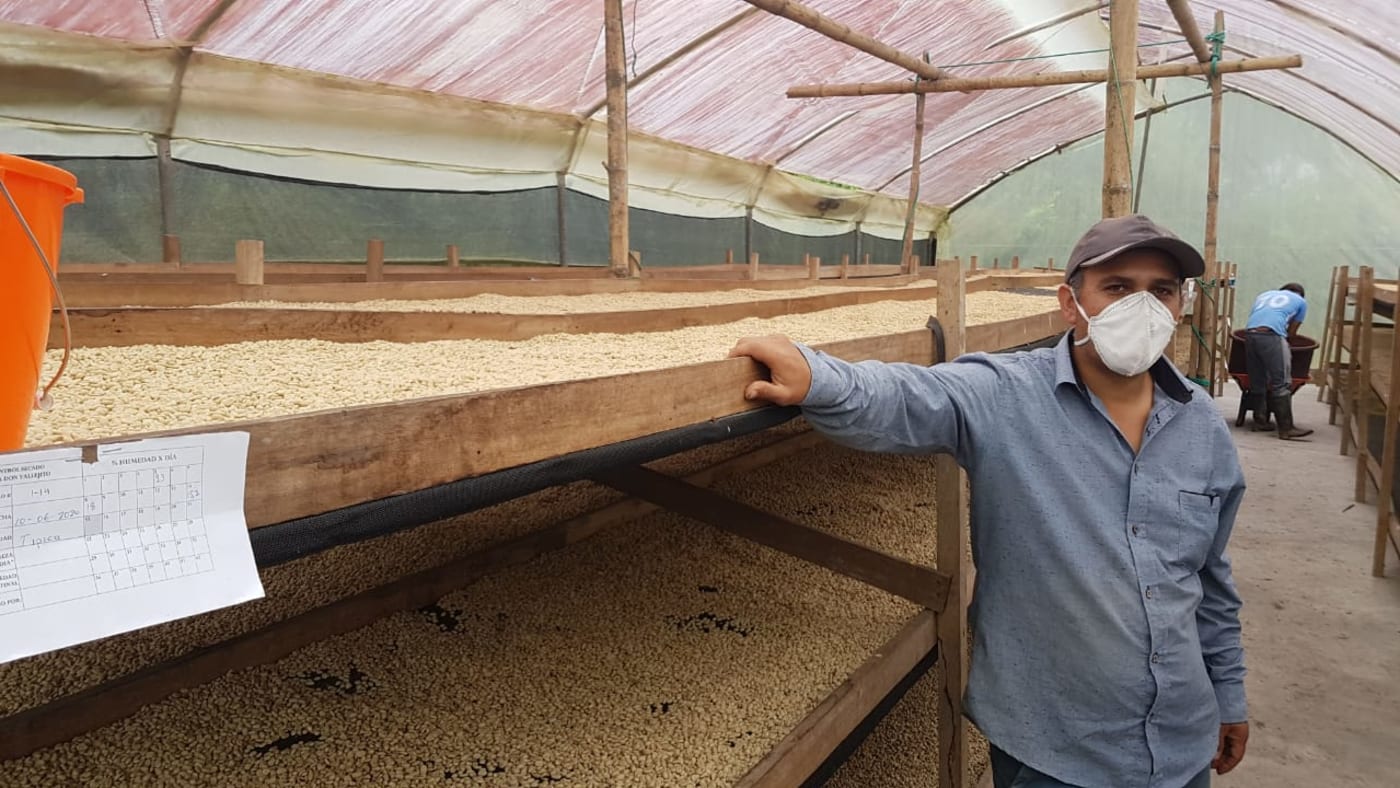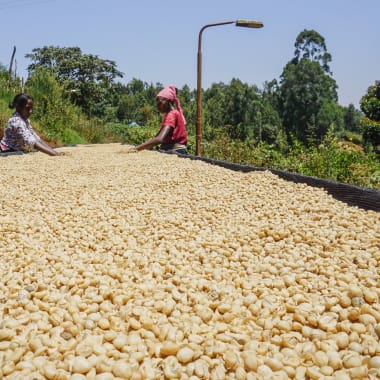-
Producer
-
Ricardo Vargas & Miriam Vallejo
-
Country
- Ecuador
-
Region
-
Quito
-
Altitude
-
1500m above sea level
-
Variety
-
Process
-
Importer
-
Caravela
-
Body
-
-
Acidity
-
-
Tasting notes
-
Finger lime, lemon sherbet
-
Roast style
Ecuador
Finca Vallejito
Seven years ago, Ricardo decided to start his own farm with his wife and named it in memory of his late father-in-law. We taste finger lime and lemon sherbet with a crisp acidity
Crisp and sparkly, this Ecuadorian washed Caturra is surely going to become a crowd favourite.
Along the highlands that surround Ecuador’s main city of Quito, you can find some quality-minded coffee growers. One such producer is Ricardo Vargas with his farm Vallejito. Ricardo’s journey in coffee started several years back when he was working as a food engineer in the private sector. He was always asked by his father-in-law to help with the processing and tree plantation of his coffee farm. This, along with his father-in-law’s ideals of creating jobs in rural areas through coffee and recognizing the potential of specialty coffee, ignited Ricardo’s passion and desire to have his own farm.

Seven years ago, Ricardo decided to start his own farm with his wife and named it in memory of his late father-in-law. Since its inception, Ricardo has been committed to specialty coffee and meticulous attention to detail. For example, when processing coffee, he keeps records of temperature and brix grades to achieve the right fermentation, and subsequently dries the coffee for 3 to 4 weeks for slow drying that allows the flavors to develop. For Ricardo, specialty coffee means taking extra care and constantly improving the infrastructure, such as drying stations and wet mill, and carefully selecting the right trees for shade. This attention to detail has resulted in increased income and a better quality of life for his family.
Ricardo takes great pride in what he has built with his family and the recognition his coffee has gained worldwide. His current challenge is to maintain profitability and quality while striving to increase the area of coffee cultivation, plant some sidra variety, and renew 30% of the crop.
All the images and information about this coffee and its producers have been kindly shared by the importer, Caravela, and edited by us, Sample Coffee (unless linked to or credited otherwise).
Resting your beans inside the sealed bag helps develop peak flavours and acidity.
Learn how long and why you should wait on our brewing window recommendations guide.
Try our step-by-step recipes and videos.
Our recipes are easy to follow and designed to bring the best out of our coffee. Find your favourite method on our brew guides collection or test a new one—and if you have any questions, ask us anytime at [email protected].
Learn everything about this coffee:
Ethical, traceable sourcing
This page has all the sourcing information (variety, process, region, story, importer, and more) that our importers share with us, and give us permission to use.
The transparency helps us talk confidently about the quality and background of our product, and it helps you know exactly what you’re buying.
Learn more:
Coffee page transparency legend
Our coffee philosophy
Our business approach
Fresh harvest coffee
We only source and roast coffee from each country’s latest harvest season (so the green coffee is never older than 1 year from the time of picking, processing and packing). This ensures the sensory qualities are always at their peak and unaffected by excessive ageing.
Roasted for espresso and filter (best enjoyed black)
Roast style: omni. Omni roasts are designed to brew and taste great both as espresso and filter. Our omni single origins generally sit on Agtron values in the ~70-60 value range. So, technically, they are somewhere in the lighter side of the medium spectrum.
Designed for espresso and filter brewing. Best enjoyed black.
Learn more:
Our Loring Kestrel S35 roaster
Our roasting style and approach
Best brewed within days 15-49 post-roast
The ‘fresh is best’ saying doesn’t apply to coffee (contrary to popular belief). Waiting before opening and brewing your bag of whole coffee beans helps develop peak flavour and acidity.
But heads up: if you buy pre-ground coffee, brew it as soon as possible.
Learn more:
Our recommended brewing window
Try our custom brewing recipes
Our recipes and ratios are tailored to our coffee sourcing and roasting styles, bringing the best flavour and feel out of each coffee.
For pour over, immersion, and other filter brewing styles, check our brew guides.
For our espresso single origins, we recommend a coffee:yield ratio of 1:3:
- Dose: 20g ground coffee
- Yield: 60g espresso
- Total brew time: ~24-28 seconds
This is just a starting point! We encourage you to experiment, taste, and adjust to find the recipe that you enjoy the most.
Learn more:
Our espresso brew guide (single origin)
Brewing ratio calculator
Packaging and sustainability
- Bags: ABA-certified home compostable (AS 5810-2010)
- Labels: recyclable
- Valves (only on +250g bags): general waste
- Box and tape (online orders): recyclable
Learn more:
Our packaging
Variety
Caturra variety
Caturra is a natural mutation of Bourbon that was originally discovered in Brazil in 1937, considered to be the first naturally occurring mutation ever discovered.
The location
Coffee from Ecuador
For a long time most of Ecuador’s coffee production was for commodity grade export or the production of soluble coffees (freeze dried coffee). Only in the last few years has the potential of the country’s coffee production been really explored. We’re very excited about the potential Ecuador and have some truly exceptional coffees
Farm processes
Washed process
Machines are used to remove the flesh from the coffee cherry before being fermented in water, washed again, and finally sun dried. This process tends to result in more distinct, cleaner flavours.

Subscribe to a world of coffee
Discover a new single origin coffee from Sample every 1-5 weeks with no delivery fees.
No up-front purchase, and you can pause, cancel, or change plans at any time.
Available to order online this week:

Colombia Carlos Imbachi Pink Bourbon
Flavours of pear, jasmine, sugarcane
Body Acidity
Washed Pink Bourbon
February 2025 harvest
Roasted omni for filter and espresso
Colombia Carlos Imbachi Pink Bourbon online
Ethiopia Girma Sintayehu Honey
Flavours of apricot, mango, coconut, pineapple
Body Acidity
Honey 75227, Wolisho
February 2025 harvest
Roasted omni for filter and espresso
Ethiopia Girma Sintayehu Honey online
Ethiopia Bekele Gemeda
Flavours of mandarin, white peach, mango
Body Acidity
Washed Ethiopian Heirloom
November 2024 harvest
Roasted omni for filter and espresso
Ethiopia Bekele Gemeda online
Kenya Karindundu Aa
Flavours of orange marmalade, grapefruit, Yunnan red tea
Body Acidity
Washed Batian, SL28, SL34, Ruiru 11
Roasted omni for filter and espresso
Kenya Karindundu Aa online